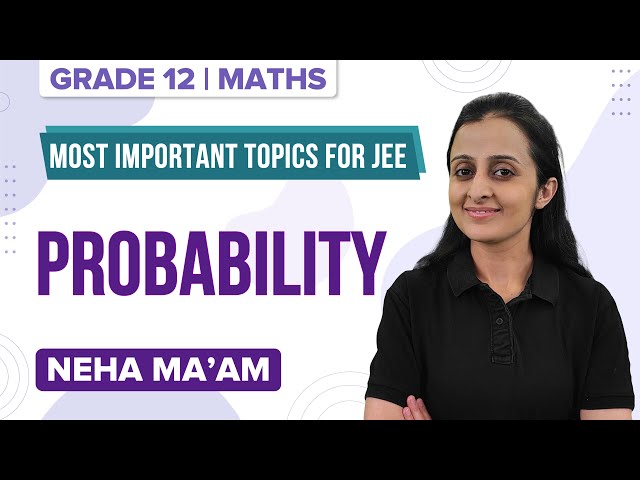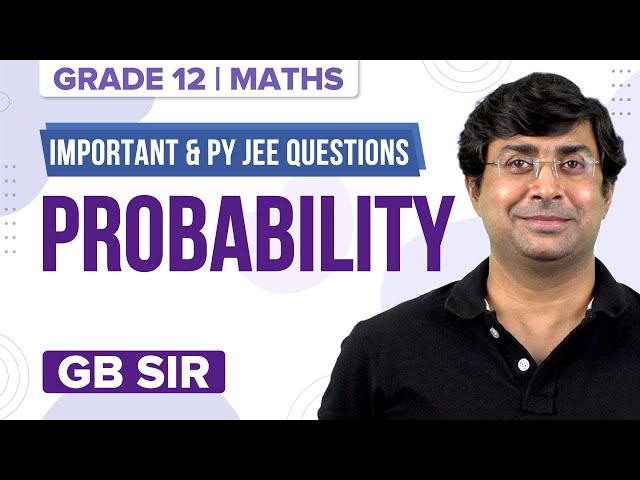The probability questions, with answers, are provided here for students to make them understand the concept in an easy way. The chapter Probability has been included in Class 9, 10, 11 and 12. Therefore, it is a very important chapter. The questions here will be provided, as per NCERT guidelines. Get Probability For Class 10 at BYJU’S.
The application of probability can be seen in Maths as well as in day to day life. It is necessary to learn the basics of this concept. The questions here will cover the basics as well as the hard level problems for all levels of students. Thus, students will be confident in solving problems based on it. Also, solving these probability problems will help them to participate in competitive exams, going further.
Definition: Probability is nothing but the possibility of an event occurring. For example, when a test is conducted, then the student can either get a pass or fail. It is a state of probability.
Also read: Probability
The probability of happening of an event E is a number P(E) such that:
0 ≤ P(E) ≤ 1
Probability Formula: If an event E occurs, then the empirical probability of an event to happen is:
P(E) = Number of trials in which Event happened/Total number of trials
The theoretical probability of an event E, P(E), is defined as:
P(E) = (Number of outcomes favourable to E)/(Number of all possible outcomes of the experiment)
Impossible event: The probability of an occurrence/event impossible to happen is 0. Such an event is called an impossible event.
Sure event: The probability of an event that is sure to occur is 1. Such an event is known as a sure event or a certain event.
Probability Questions & Answers
1. Two coins are tossed 500 times, and we get:
Two heads: 105 times
One head: 275 times
No head: 120 times
Find the probability of each event to occur.
Solution: Let us say the events of getting two heads, one head and no head by E1, E2 and E3, respectively.
P(E1) = 105/500 = 0.21
P(E2) = 275/500 = 0.55
P(E3) = 120/500 = 0.24
The Sum of probabilities of all elementary events of a random experiment is 1.
P(E1)+P(E2)+P(E3) = 0.21+0.55+0.24 = 1
2. A tyre manufacturing company kept a record of the distance covered before a tyre needed to be replaced. The table shows the results of 1000 cases.
| Distance(in km) | Less than 4000 | 4000 to 9000 | 9001 to 14000 | More than 14000 |
| Frequency | 20 | 210 | 325 | 445 |
If a tyre is bought from this company, what is the probability that :
(i) it has to be substituted before 4000 km is covered?
(ii) it will last more than 9000 km?
(iii) it has to be replaced after 4000 km and 14000 km is covered by it?
Solution: (i) Total number of trials = 1000.
The frequency of a tyre required to be replaced before covering 4000 km = 20
So, P(E1) = 20/1000 = 0.02
(ii) The frequency that tyre will last more than 9000 km = 325 + 445 = 770
So, P(E2) = 770/1000 = 0.77
(iii) The frequency that tyre requires replacement between 4000 km and 14000 km = 210 + 325 = 535.
So, P(E3) = 535/1000 = 0.535
3. The percentage of marks obtained by a student in the monthly tests are given below:
| Test | 1 | 2 | 3 | 4 | 5 |
| Percentage of marks obtained | 69 | 71 | 73 | 68 | 74 |
Based on the above table, find the probability of students getting more than 70% marks in a test.
Solution: The total number of tests conducted is 5.
The number of tests when students obtained more than 70% marks = 3.
So, P(scoring more than 70% marks) = ⅗ = 0.6
4. One card is drawn from a deck of 52 cards, well-shuffled. Calculate the probability that the card will
(i) be an ace,
(ii) not be an ace.
Solution: Well-shuffling ensures equally likely outcomes.
(i) There are 4 aces in a deck.
Let E be the event the card drawn is ace.
The number of favourable outcomes to the event E = 4
The number of possible outcomes = 52
Therefore, P(E) = 4/52 = 1/13
(ii) Let F is the event of ‘card is not an ace’
The number of favourable outcomes to F = 52 – 4 = 48
The number of possible outcomes = 52
Therefore, P(F) = 48/52 = 12/13
| Complementary Events: If P(E) is the probability of an event and P(not E) is the probability of an event not happening, then:
P(E) + P(not E) = 1 P(not E) = 1-P(E) |
5. Two players, Sangeet and Rashmi, play a tennis match. The probability of Sangeet winning the match is 0.62. What is the probability that Rashmi will win the match?
Solution: Let S and R denote the events that Sangeeta wins the match and Reshma wins the match, respectively.
The probability of Sangeet to win = P(S) = 0.62
The probability of Rashmi to win = P(R) = 1 – P(S)
= 1 – 0.62 = 0.38
| Outcomes: A possible result of a random experiment.
Sample space: The set of outcomes in a random experiment Sample point: Each element of sample space Example: Say, rolling a die. Outcomes = 1,2,3,4,5 or 6 Sample space = {1,2,3,4,5,6} |
6. Two coins (a one rupee coin and a two rupee coin) are tossed once. Find a sample space.
Solution: Either Head(H) or Tail(T) can be the outcomes.
Heads on both coins = (H,H) = HH
Head on 1st coin and Tail on the 2nd coin = (H,T) = HT
Tail on 1st coin and Head on the 2nd coin = (T,H) = TH
Tail on both coins = (T,T) = TT
Therefore, the sample space is S = {HH, HT, TH, TT}
7. Consider the experiment in which a coin is tossed repeatedly until a head comes up. Describe the sample space.
Solution: In the random experiment where the head can appear on the 1st toss, or the 2nd toss, or the 3rd toss and so on till we get the head of the coin. Hence, the required sample space is :
S= {H, TH, TTH, TTTH, TTTTH,…}
8. Consider the experiment of rolling a die. Let A be the event ‘getting a prime number’, B be the event ‘getting an odd number’. Write the sets representing the events
(i) Aor B
(ii) A and B
(iii) A but not B
(iv) ‘not A’.
Solution: S = {1, 2, 3, 4, 5, 6}, A = {2, 3, 5} and B = {1, 3, 5}
(i) A or B = A ∪ B = {1, 2, 3, 5}
(ii) A and B = A ∩ B = {3,5}
(iii) A but not B = A – B = {2}
(iv) not A = A′ = {1,4,6}
9. A coin is tossed three times, consider the following events.
P: ‘No head appears’,
Q: ‘Exactly one head appears’ and
R: ‘At Least two heads appear’.
Check whether they form a set of mutually exclusive and exhaustive events.
Solution: The sample space of the experiment is:
S = {HHH, HHT, HTH, THH, HTT, THT, TTH, TTT} and
P = {TTT},
Q = {HTT, THT, TTH},
R = {HHT, HTH, THH, HHH}
P ∪ Q ∪ R = {TTT, HTT, THT, TTH, HHT, HTH, THH, HHH} = S
Therefore, P, Q and R are exhaustive events.
And
P ∩ Q = φ,
P ∩ R = φ and
Q ∩ R = φ
Therefore, the events are mutually exclusive.
Hence, P, Q and R form a set of mutually exclusive and exhaustive events.
| Conditional Probability: This probability of the event E is called the conditional probability of E given that F has already occurred, and is denoted by P (E|F).
P(E|F) = Number of elementary events favourable to E∩F/Number of elementary events which are favourable to F P(E|F) = n(E∩F)/n(F) Or P(E|F) = P(E∩F)/P(F) where P(F) ≠ 0 |
10. If P(A) = 7/13, P(B) = 9/13 and P(A∩B) = 4/13, evaluate P(A|B).
Solution: P(A|B) = P(A∩B)/P(B) = (4/13)/(9/13) = 4/9.
Video Lesson
Probability Important Topics

Probability Important Questions

Related Links
- Important Questions Class 9 Maths Chapter 15 Probability
- Important Questions Class 10 Maths Chapter 15 Probability
- Important Questions Class 11 Maths Chapter 16 Probability
- Important Questions Class 12 Maths Chapter 13 Probability
Practice Questions
Solve the following probability questions.
- Write the sample space for rolling two dice.
- If two coins are tossed simultaneously, what is the probability of getting exactly two heads?
- From a well-shuffled deck of 52 cards, what is the probability of getting a king?
- In a bag, there are 5 red balls and 7 black balls. What is the probability of getting a black ball?
- If the probability of an event happening is 0.7, then what is the probability of an event that will not happen?
Stay tuned with BYJU’S – The Learning App and learn all Maths-related concepts easily by exploring more videos.
Comments